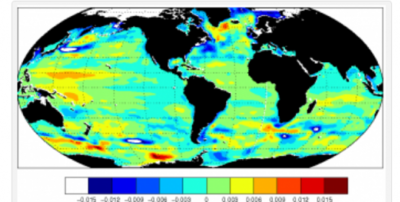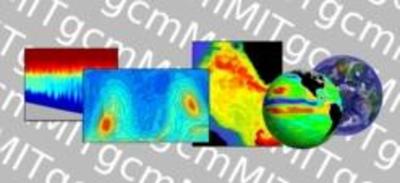Ocean Modeling
The ocean is a stratified fluid on a rotating Earth governed by the laws of mechanics and thermodynamics, driven from its upper surface by patterns of momentum and buoyancy fluxes. The ocean contains a wide variety of phenomena on a plethora of space and time scales, ranging from tides, internal gravity waves, large-scale ocean currents and geostrophic turbulence. Modeling the ocean is a formidable challenge; it is a turbulent fluid containing energetically active scales ranging from the global down to order 1 to 10km horizontally and some tens of meters vertically. Important scale interactions occur over the entire spectrum. The ocean also interacts with the cryosphere (land and sea-ice) and harbors life which plays a central role in biogeochemical cycles.
Researches in PAOC are driving forward modeling of the ocean both in its physical (water and ice) and biogeochemical aspects. To this end, much effort is being devoted to developing:
- algorithms that seamlessly range from convective (non-hydrostatic) scales to balanced (hydrostatic) motions of planetary scale
- inverse methodologies and code that interface models with observations
- biogeochemical and self-assembling ecosystem models that incorporate aspects of natural selection
- novel approaches to coupled modeling employing atmosphere/ocean isomorphisms to render models of both fluids from a single hydrodynamical kernel.
Centers & Initiatives
The Climate Modeling Initiative is an open-source collaborative based at MIT which has developed a modeling infrastructure for the study of the atmosphere, ocean and climate of the Earth.
Understanding the ways in which the ocean interacts with the remainder of the climate system is one of the most interesting and challenging of scientific problems.
The MITgcm (MIT General Circulation Model) is a numerical model designed for study of the atmosphere, ocean, and climate. By employing fluid isomorphisms, one hydrodynamical kernel can be used to simulate flow in both the atmosphere and ocean.
Groups
John Marshall's group studies the general circulation of the ocean and its role in the global climate.
We use models and data analysis to investigate the connections between ocean circulation, biogeochemical cycles and marine ecosystems.
Paola Rizzoli's Group is currently working on modelling tropical ocean behaviour and data assimilation in the Singapore Strait, as well as regional climate simulations connecting the regional model of the Maritime Continent to the Integrated Global S...
Chris Hill's work centers on how digital computing technology in its broadest sense applies to Earth science and especially the ocean.
The overarching theme of our research rests on the recognition that many elements of the present climate remain poorly sampled by observations, preventing a quantitative mechanistic understanding of climate variability and change over the past decade...
Professor Ferrari's Group is interested in the dynamics of the ocean, its interactions with present and past climates, and its coupling to biogeochemistry.



